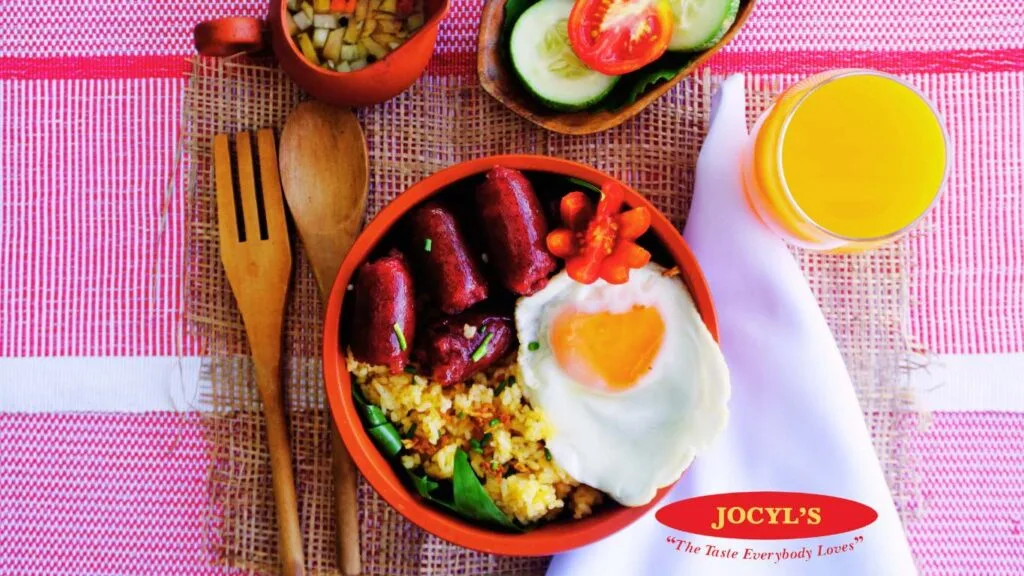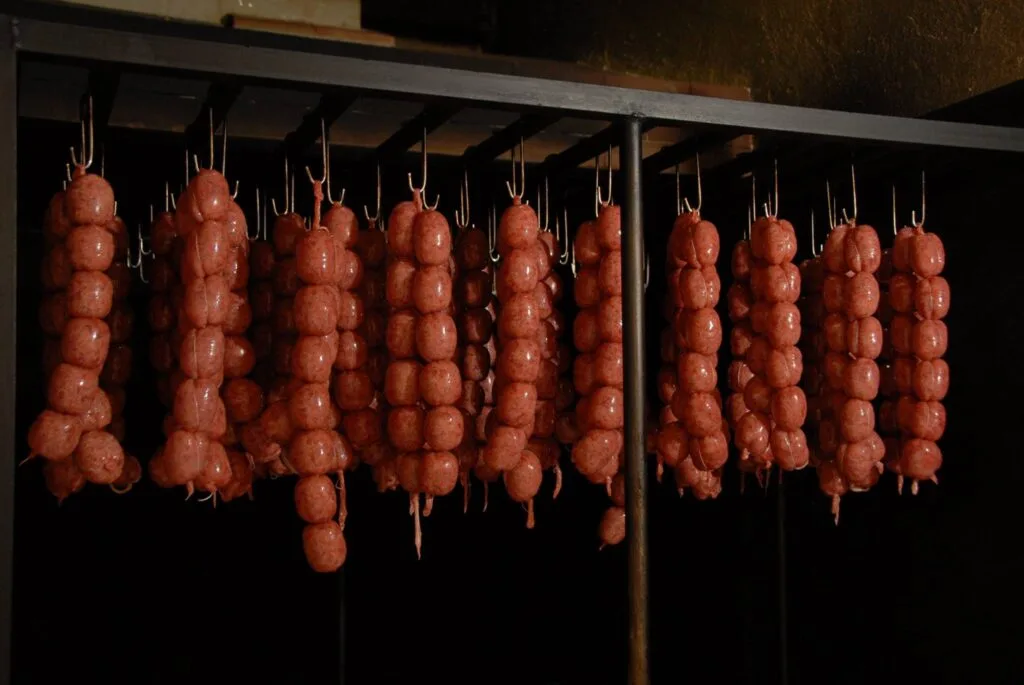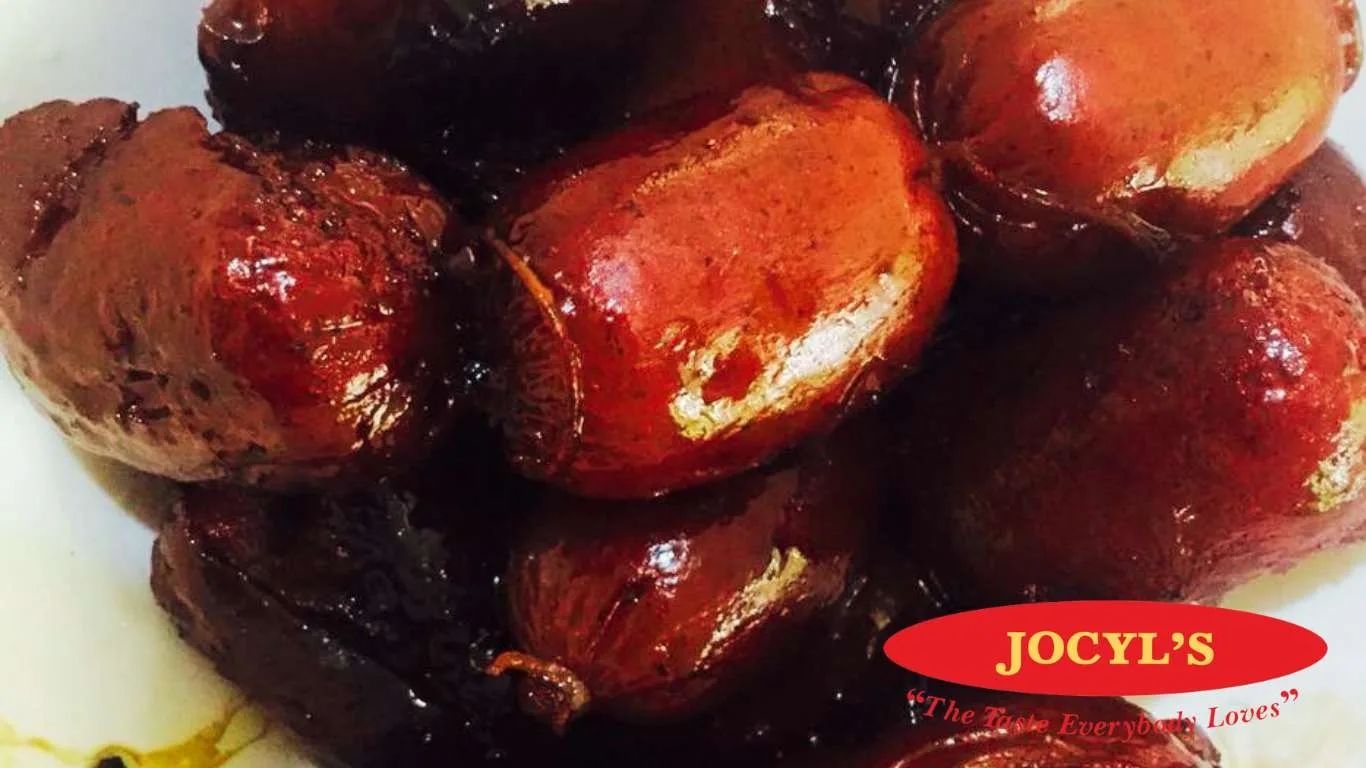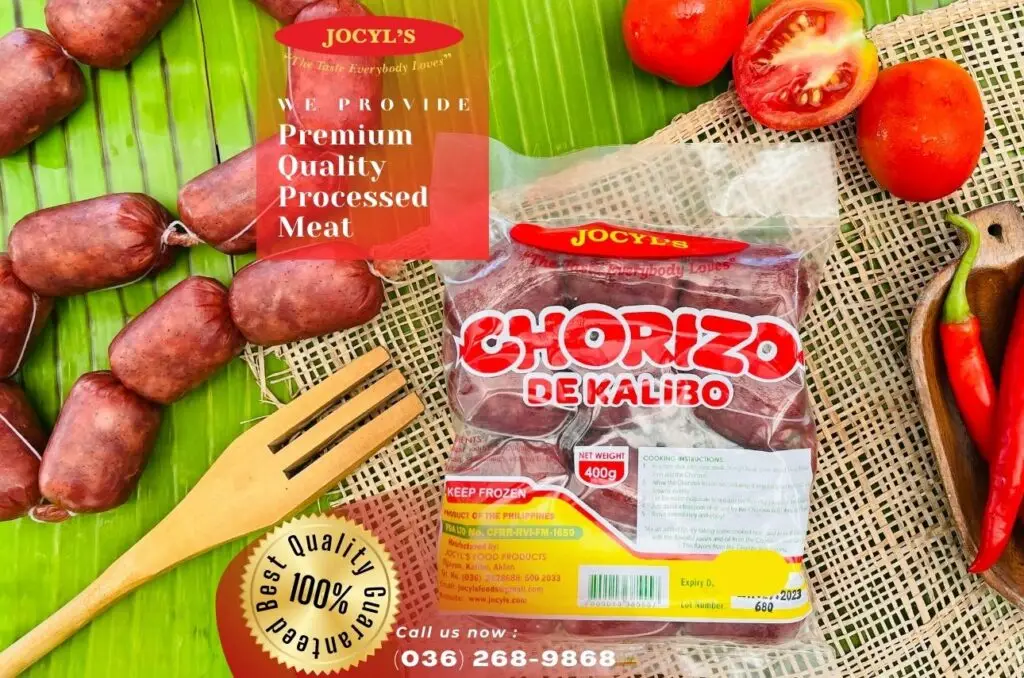
About Us
Jocyl's Food Products (a.k.a "Chorizo de Kalibo") is a bold and forward-thinking company whose goals are set to create surprising ways of developing and promoting our products. We are entrepreneurial and visionary in producing and marketing the best chorizo and other food products from our hometown - Kalibo, Aklan, Philippines.
About UsContact Info
- Tigayon Highway, Barangay Tigayon, Kalibo, Aklan
- +63362628688
- jocylsfoods@gmail.com
- Tigayon Highway, Barangay Tigayon, Kalibo, Aklan
- jocylsfoods@gmail.com
- +63362628688

Quick & Easy: Homemade Filipino Chorizo Step by Step Guide, Tasty Bite
-
Jocyl's Food Products > Blog > Food > Quick & Easy: Homemade Filipino Chorizo Step by Step Guide, Tasty Bite
Homemade Filipino Chorizo Step By Step Guide
Filipino chorizo isn’t just a breakfast staple—it celebrates our rich culinary heritage with bold flavors and a touch of sweetness. In this guide, we show you how to craft your very own homemade Filipino chorizo from scratch. You’ll discover everything you need—from the essential ingredients and tools to a clear, step-by-step process. Whether you’re an experienced cook or a curious beginner, you’ll enjoy the authenticity, simplicity, and irresistible taste of this classic sausage.

What Makes Filipino Chorizo Special?
Filipino chorizo features a distinct, slightly sweet flavor profile that sets it apart from its spicier Spanish cousin. Enjoy it at breakfast with garlic fried rice (sinangag) and eggs, or use it to add depth to stews, grilled dishes, and more. Traditionally, cooks make this sausage using ground pork, local spices, vinegar, and occasionally annatto for a signature red hue. Its versatility and robust taste endear it to Filipino households, making it a beloved comfort food.

Essential Ingredients and Tools
Ingredients
To produce authentic Filipino chorizo, gather these high-quality ingredients:
- Ground Pork: Use a mix with about 80% lean meat and 20% fat to keep your sausage juicy.
- Garlic: Finely minced fresh garlic delivers the backbone of flavor.
- Vinegar: Filipino recipes call for cane or white vinegar, which tenderizes the meat while adding a subtle tang.
- Sugar: A touch of sugar introduces a unique sweetness that contrasts with the tangy vinegar.
- Salt and Pepper: Season with salt and pepper to enhance and balance the flavors.
- Spices: Incorporate bay leaves, paprika, or a pinch of chili flakes if you prefer a slight kick.
- Annatto Powder (Optional): This ingredient lends a vibrant red color and a subtle earthy note.
- Sausage Casings: Use natural pork casings for an authentic texture; synthetic casings work if needed.
Tools
Equip your kitchen with the following tools:
- Mixing Bowls: Use large bowls to blend the meat and spices thoroughly.
- Food Processor or Knife: Mince garlic and finely chop other ingredients.
- Sausage Stuffer: Whether manual or electric, a stuffer fills the casings evenly.
- Meat Grinder (Optional): Grind whole cuts of pork if you prefer to prepare your own meat.
- Refrigerator: Chill the mixture so the flavors meld perfectly.
- Kitchen Twine: Tie off the sausages after filling the casings for neat links.
High-quality ingredients and the right tools deliver an authentic homemade taste you can be proud of.
Step-by-Step Guide to Making Filipino Chorizo
To streamline the process, we’ve divided the guide into two parts: Preparation & Mixing and Stuffing, Cooking, and Serving.
Part 1: Preparation & Mixing
Step 1: Prepare Your Ingredients
Before you start, get all your ingredients ready:
- Meat Preparation: If you plan to grind your own pork, cut it into manageable chunks. Chill the meat well to maintain proper texture during mixing.
- Mince and Measure: Finely mince your garlic and measure out the vinegar, sugar, salt, pepper, and chosen spices. Pre-measuring guarantees a smooth process and consistent flavor.
Step 2: Mixing the Meat and Spices
Combine the Ingredients:
Place the ground pork, minced garlic, vinegar, sugar, salt, pepper, and any extra spices in a large bowl. If you’re adding annatto powder, incorporate it evenly.
Mix Thoroughly:
Mix the ingredients by hand or with a sturdy spatula. Distribute the spices evenly throughout the meat so that every bite bursts with balanced flavor.
Rest the Mixture:
After mixing, cover the bowl and refrigerate the mixture for at least 30 minutes. This pause lets the flavors meld and achieves a uniform taste when cooked.

Part 2: Stuffing, Cooking, and Serving
Step 3: Stuffing the Casings
Prepare the Casings:
Rinse your sausage casings thoroughly. For natural casings, soak them in warm water for about 30 minutes before use. Soaking softens the casings and makes them easier to handle.
Set Up the Sausage Stuffer:
Attach your casing to the sausage stuffer and feed the meat mixture into it. Avoid overloading the stuffer to ensure even filling.
Fill and Tie the Casings:
Fill the casings carefully, applying steady pressure to eliminate air pockets. If you’re new to this process, proceed slowly to achieve an even fill. After filling, tie off the sausage at regular intervals using kitchen twine, creating individual links that are ready to cook or store.
Step 4: Cooking and Curing
Optional Curing for Enhanced Flavor:
For a more intense taste, let the sausages cure in the refrigerator for a few hours or overnight. Although this step is optional, it intensifies the seasoning.
Explore Cooking Methods:
You can cook Filipino chorizo in several ways:
- Pan-Frying: Heat a little oil in a skillet over medium heat, then fry the sausages until they turn golden brown and are fully cooked.
- Grilling: Preheat your grill and cook the sausages until they develop a smoky char.
- Steaming: For a healthier option, steam the sausages until cooked through and finish by searing them lightly for extra flavor.
Check for Doneness:
Cook the chorizo until its internal temperature reaches at least 160°F (71°C) to ensure it is safe to eat.
Step 5: Serving Suggestions
Discover the versatility of your homemade Filipino chorizo with these serving ideas:
- Breakfast Combo: Serve the sausage with garlic fried rice (sinangag) and a sunny-side-up egg.
- Pancit Canton: Thinly slice the chorizo and toss it into your favorite noodle dishes.
- Skewers and Grill: Thread the sausages onto skewers and grill them for a smoky, outdoor treat.
- Sandwiches: Use chorizo as a flavorful filling in your preferred sandwiches or buns.
Tips and Tricks for Perfect Chorizo
Quality of Meat
- Fat Ratio: Use a pork mix with about 20% fat to keep your chorizo moist and full of flavor.
- Chill the Meat: Always work with cold meat; this technique preserves the proper consistency when stuffing the casings.
Mixing Techniques
- Even Seasoning: Take your time so that every portion of the meat gets well-seasoned.
- Taste Test: Cook a small sample of the mixture before filling the casings. Tasting helps you adjust the seasoning as needed.
Stuffing the Casings
- Prevent Air Pockets: Proceed slowly and evenly to avoid trapping air pockets, which can cause uneven cooking.
- Uniform Links: Maintain consistent link sizes for even cooking across all pieces.
Storage and Shelf Life
- Refrigeration: Store your homemade chorizo in an airtight container in the refrigerator for up to 3–4 days.
- Freezing: For extended storage, freeze the chorizo in airtight containers or vacuum-sealed bags. Thaw in the refrigerator when ready to use.
Variations and Regional Twists for Homemade Filipino Chorizo Step By Step Guide
Although the basic recipe stays consistent, regional variations exist across the Philippines. Some cooks incorporate different spice blends, finely chopped onions, or a dash of citrus zest for extra brightness. Experiment with small tweaks to discover your perfect version while still honoring tradition.

If you prefer convenience without compromising quality, try premium products like Jocyl’s Chorizo De Kalibo and BIDA Chorizo Smoked. These ready-to-cook options capture the authentic taste and texture of Filipino chorizo and deliver consistent flavor whether for everyday meals or special occasions.
Health and Nutritional Considerations – – Homemade Filipino Chorizo Step by Step Guide
Making chorizo at home gives you control over both flavor and ingredients. Choose high-quality pork and natural seasonings to avoid the preservatives and additives found in many commercial products. You can also adjust the levels of sugar or salt to suit your dietary needs. Enjoy a savory treat that fits into your nutritional goals without sacrificing taste.
Health-conscious cooks can balance fat content and seasoning to create a wholesome dish that complements a balanced diet. Plus, crafting your own chorizo lets you experiment with organic or locally sourced ingredients, enhancing the overall quality of your meal.
Final Thoughts – Homemade Filipino Chorizo Step by Step Guide
Homemade Filipino chorizo goes beyond a simple recipe—it invites you to celebrate one of the Philippines’ most cherished flavors. Every step, from carefully preparing the ingredients to the satisfaction of filling each casing by hand, makes the process both rewarding and enjoyable. Whether you choose to cook your chorizo immediately or let it cure to deepen its flavor, the final product is a delicious, authentic bite you’ll be proud to share.

Embrace the process and experiment with your favorite variations. Don’t hesitate to add your own twist along the way. And if you’re pressed for time or seek a consistent, premium flavor experience, consider our featured products—Jocyl’s Chorizo De Kalibo and BIDA Chorizo Smoked—which deliver the true taste of Filipino chorizo in a convenient, ready-to-cook format.
Q & A – Homemade Filipino Chorizo Step by Step Guide
Q: Can I adjust the seasoning in my homemade chorizo?
A: Absolutely. You control the spices, sugar, and salt. Start with the suggested amounts, then cook a small sample to taste before filling all the casings.
Q: How long should I let the chorizo cure before cooking?
A: Allow the sausages to cure in the refrigerator for a few hours or overnight. While optional, curing intensifies the flavor.
Q: What cooking method works best for homemade chorizo?
A: You have many options. Pan-frying creates a crispy exterior, while grilling adds a smoky char. Choose the method that suits your taste and equipment.
Q: How should I store any leftovers?
A: Refrigerate any uncooked chorizo in an airtight container for 3–4 days, or freeze it in vacuum-sealed bags for longer storage. Thaw in the refrigerator before use.
Q: Where can I find premium, ready-to-cook Filipino chorizo?
A: For consistent, top-quality flavor, check out Jocyl’s Chorizo De Kalibo or try BIDA Chorizo Smoked.
This comprehensive guide now offers varied sentence structures, active voice, and clearer subheading breaks—all designed to boost readability while preserving authenticity and factual accuracy. Enjoy creating and savoring your homemade Filipino chorizo!
Jocyl’s Social Media:
https://www.facebook.com/jocylsfoods
https://www.instagram.com/jocylsfoods
https://www.twitter.com/jocylsfoods
https://www.pinterest.ph/jocylsfoods
https://www.tiktok.com/@jocylsfoodsproducts
Recent Posts
- The Ultimate Guide to Authentic Filipino Breakfast: Why Chorizo de Kalibo Is Taking 2026 to the next level!
- Ultimate Aklan Pasalubong Guide: Authentic Filipino Treasures
- How to Cook Longganisa Without Oil: Easy, Healthy & Delicious Guide
- Ultimate Guide: How to Cook Ilonggo Longganisa – Perfect Every Time!
- What is Ilonggo Food? Discover the Rich Flavors of Western Visayas Cuisine
Recent Comments
Archives
- October 2025
- September 2025
- August 2025
- July 2025
- May 2025
- April 2025
- March 2025
- February 2025
- January 2025
- November 2024
- October 2024
- September 2024
- August 2024
- June 2024
- March 2024
- February 2024
- January 2024
- December 2023
- November 2023
- October 2023
- August 2023
- July 2023
- June 2023
- May 2023
- April 2023
- March 2023
- February 2023
Tags
- Aklan
- Aklan Pasalubong
- Boracay
- Boracay Food
- Boracay Island
- Boracay Pasalubong
- boracay snacks
- Boracay Souvenirs
- Breakfast
- Chicken
- chicken tocino
- Chori Burger
- chorizo
- ChorizoDeKalibo
- chorizo recipe
- Delicacies
- embutido
- embutido recipe
- Filipino Chorizo
- Filipino Cuisine
- filipino food
- Filipino Longganisa
- Filipino Sausage
- foodie guide
- homemade
- Iloilo
- Iloilo Chorizo
- Iloilo Food
- Iloilo Longganisa
- Iloilo Pasalubong
- ingredients
- JocylsFoods
- longaniza
- longganisa
- longganisa recipe
- meat
- Pasalubong
- pinoy recipes
- pork tocino
- recipe
- Recipes
- skinless longganisa
- snacks
- tocino
- tocino recipe










